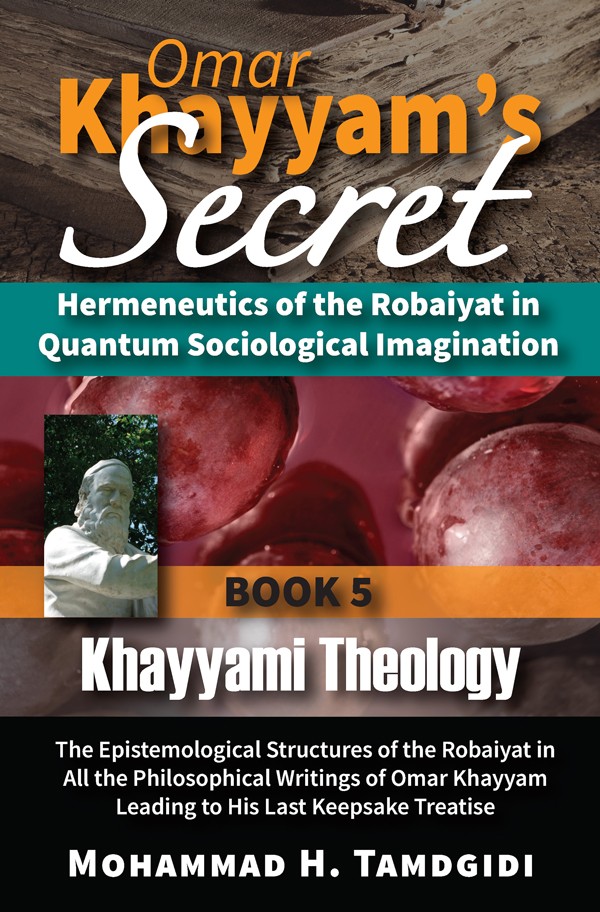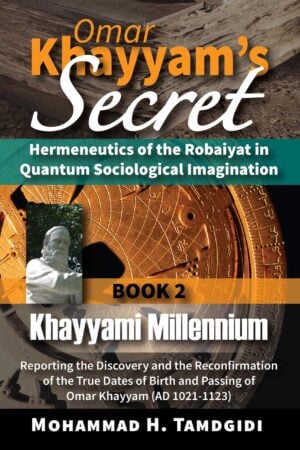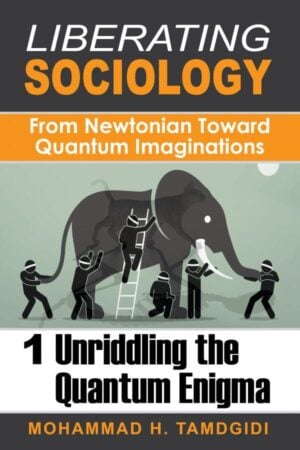Book Section: CHAPTER III — Part 1 of Omar Khayyam’s Treatise on Existence Addressed to Abu Taher Regarding the Necessity of Contradiction, Determinism, and Survival: The Arabic Manuscript and Updated Persian and New English Translations, Followed by Textual Analysis — by Mohammad H. Tamdgidi
$20.00
This essay, titled “Part 1 of Omar Khayyam’s Treatise on Existence Addressed to Abu Taher Regarding the Necessity of Contradiction, Determinism, and Survival: The Arabic Manuscript and Updated Persian and New English Translations, Followed by Textual Analysis” is the third chapter of the book Khayyami Theology: The Epistemological Structures of the Robaiyat in All the Philosophical Writings of Omar Khayyam Leading to His Last Keepsake Treatise, which is the fifth volume of the twelve-book series Omar Khayyam’s Secret: Hermeneutics of the Robaiyat in Quantum Sociological Imagination, authored by Mohammad H. Tamdgidi.
Description
Abstract
This essay, titled “Part 1 of Omar Khayyam’s Treatise on Existence Addressed to Abu Taher Regarding the Necessity of Contradiction, Determinism, and Survival: The Arabic Manuscript and Updated Persian and New English Translations, Followed by Textual Analysis” is the third chapter of the book Khayyami Theology: The Epistemological Structures of the Robaiyat in All the Philosophical Writings of Omar Khayyam Leading to His Last Keepsake Treatise, which is the fifth volume of the twelve-book series Omar Khayyam’s Secret: Hermeneutics of the Robaiyat in Quantum Sociological Imagination, authored by Mohammad H. Tamdgidi.
The manuscript explored in this chapter, most likely dated 473 LH (AD 1080-81) has been generally titled as “Answers to Three Questions: On the Necessity of Contradiction, Determinism, and Survival.” However, the original manuscript based on which most of the later editions of the manuscript has been reproduced offers only “On the Necessity of Contradiction” as a title for the writing. Further study of the treatise in the chapter reveals that indeed the title most fitting for the treatise is that of the necessity of contradiction, given the questions regarding determinism and survival can be regarded as sub-topics of the same unifying topic on the necessity of contradiction.
In the chapter Tamdgidi presents an updated Arabic text for the “Treatise on the Necessity of Contradiction,” one that he has cross-checked with the original manuscript copied in 699 LH (about AD 1299-1300), which is among three pieces of writing attributed to Omar Khayyam included in that collection. There are a few items that are either missing from or not accurately rendered in the versions of the Arabic text circulating for this manuscript, which Tamdgidi identifies and corrects in his rendition of the Arabic original. Following the Arabic text, he then presents his updated Persian (building on prior efforts by scholars) and new English translations for this writing by Omar Khayyam.
In this chapter, Tamdgidi argues that this treatise is in fact not addressed to Abu Nasr Nasawi (for whom Khayyam wrote his treatise on the created world and worship duty), but to Abu Taher, the supreme judge of the Fars region, to whom Khayyam had several years earlier dedicated his important treatise on algebra. In the introduction of that treatise, Khayyam in fact had noted that he was going to write a series of materials in dedication to him to begin which he found (as stated therein) the treatise on algebra to be more appropriate. So, the treatise we are studying in this chapter and the two to follow (in the following chapters), are altogether a three-part treatise on existence which Khayyam wrote addressed to Abu Taher.
The question Khayyam presents as if quoting from the questioner basically says, if “the necessity of contradiction” is a possible existent, it is caused by a necessary existent that would trace back ultimately to God, and since contradiction implies existence of evil, then somehow Khayyam is accused either of denying the oneness or unity of God, or that God is a source of the evil found in the world. The way Khayyam himself had posed a similar question in his treatise on the created world and worship duty lent itself to the notion that even a lesser evil is still evil, and Khayyam was admitting such a possibility, so he found himself in a situation where someone actually asked the question. Note that Khayyam already provided the basic elements of his explanation in his earlier treatise on creation and worship duty in terms of a “crowding” of contradictory aspects, and this is the point he amplifies and elaborates on in the treatise we explore in this chapter. In Khayyam’s view, what the questioner has missed in raising his question is the distinction between the essential and the accidental attributes of things. For this reason, he begins his answer by offering a basic definitional framework for types of attributes, sharing the strategies he used to explain the nature of existence.
To offer his typology, Khayyam establishes an important epistemological framework for answering the question. He encourages his reader to always keep a distinction between the essential capacities and the accidental/incidental actualizations of those capacities which can themselves be less or more separable from the attributed depending on the extent to which those essential capacities are actualized. Why has Khayyam adopted this strategy of answering the question by offering a typology about the essential and variously separable accidental attributes of humankind? Because in his view the determination of whether or not evil can be attributed to God’s creations has everything to do with the distinction between the essential capacities and the actualized accidental attributes of those creations, when it comes to the creation of a humankind endowed with intelligence, which necessarily implies having the power of will; for the same reasons, we should not be surprised to see the questions about determinism and also survival come up in the treatise, not as separate questions, but as one integral to the question of the necessity of contradiction.
To best interpret what Khayyam is doing in this treatise in response to the question asked about the source of evil found in the world, and its being somehow related to the necessity of contradiction, we need to note how Khayyam is insisting on the distinction between the essential and the accidental causes particularly arising from the nature of humankind as an intelligent, speech-endowed, species, an attribute which implies at its core the capacity to have the power of will, i.e., to consciously and intentionally act, or not, if subjected to thoughtless spontaneity or habitual behavior.
When we ask the question “is there evil in the world, and does the necessity of contradiction imply the necessity of evil?” we have to always keep in mind that such a question can only be raised by an intelligent species that is asking the question, and is essentially endowed with a capacity of intellecting that offers it a choice to act good or evil, and to reflect (or not) on that choice or behavior. So, asking the question while somehow assuming that what goes on in the world is objectively separate from the subjective world of those who have an essential capacity to make a choice and reflect, would itself be a highly problematic notion.
The notion that God allowed for a lesser evil because of a greater good may seem like a rather “quantitative” way of going about avoiding evil. Little evil is still evil, and from an Omnipotent God, one should expect more, the skeptics may argue. But understanding Khayyam’s argument in terms merely of the lesser evil versus higher good misses the whole point of his argument. Khayyam is not arguing that God allowed for a lesser evil to save a greater good, but that nothing evil was created or intended in the first place. There is no way you can create a willful creature, without giving him or her a capacity to choose between good and evil. And if the creature acts evil, it does not in any way undermine the absolute goodness of creating a willful species.
To deepen his argument in the treatise, by insightfully introducing three epistemological concepts, “Tashkik,” “Tavato,” and “Eshterak,” Khayyam further offers a glimpse into a non-binary, Avicennian (unitary Islamic), not Aristotelian (dualistic), way of going about conceptualizing double-meanings of concepts. The reason such a conceptual framework introduced in Khayyam’s treatise has hermeneutic significance for our understanding Khayyam’s literary strategy, especially regarding his poetic practice, is that the highly nuanced way he distinguishes the three different ways of constructing ascribed double-meanings is essential to the practice of poetry. Khayyam demonstrates here, explicitly, an awareness of the ways he can go about constructing metaphors that on the surface may mean something, but at once imply a variety or set of multiple meanings that are either gradationally ranked, or equivalent, or metaphorical.
We need to take note here that even the topic of “survival” with which Khayyam concludes his treatise is itself linked to both the topic of the necessity of contradiction, and even the question of determinism. The issue of the necessity of contradiction not only brings up the question of evil’s attributability to the Necessary Being, God, but, once the distinction between the essential and accidental attributes is taken into consideration, the question is raised of how such an order could be determined and maintained. So, whether the order is deterministic or not comes into play in light of the role played by accidentality in the world, and it is as much a question needing to be addressed as how such an order could be maintained and “survive” in such a way that would allow both the continuity of God’s creative model while allowing for its accidental nature as a world of possibilities to also be accommodated. After all, if there is a necessity of contradiction in the world, it would be necessary to understand how such a contradiction-prone world can “survive” the “succession order” of its creation trajectory in both its descending and ascending curves from and to toward its First Cause.
Recommended Citation
Tamdgidi, Mohammad H. 2022. “CHAPTER III — Part 1 of Omar Khayyam’s Treatise on Existence Addressed to Abu Taher Regarding the Necessity of Contradiction, Determinism, and Survival: The Arabic Manuscript and Updated Persian and New English Translations, Followed by Textual Analysis.” Pp. 175-236 in Omar Khayyam’s Secret: Hermeneutics of the Robaiyat in Quantum Sociological Imagination: Book 5: Khayyami Theology: The Epistemological Structures of the Robaiyat in All the Philosophical Writings of Omar Khayyam Leading to His Last Keepsake Treatise. (Human Architecture: Journal of the Sociology of Self-Knowledge: Vol. XVIII, 2022. Tayyebeh Series in East-West Research and Translation.) Belmont, MA: Okcir Press.
Where to Purchase Complete Book: The various editions of the volume of which this Book Section is a part can be ordered from the Okcir Store and all major online bookstores worldwide (such as Amazon, Barnes&Noble, Google Play, and others).
Read the Above Publication Online
To read the above publication online, you need to be logged in as an OKCIR Library member with a valid access. In that case just click on the large PDF icon below to access the publication. Make sure you refresh your browser page after logging in.
KHB6E-PREVIEWNOCOVER






